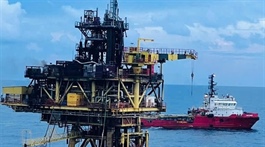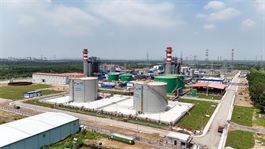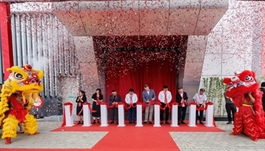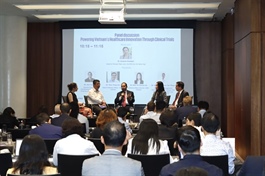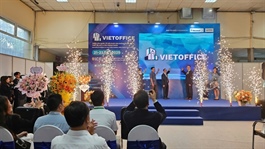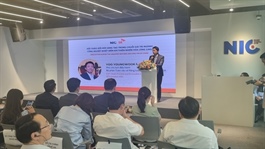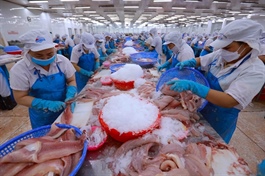Greener building materials enter the Vietnamese market
Greener building materials enter the Vietnamese market
The rise of green buildings is driving stricter standards for construction materials, prompting many businesses to improve product quality and sharpen their competitive edge.
Just over a month ago, Vietnam Electric Cable Corporation (CADIVI) introduced an environmentally friendly product line, including electrical cables using lead-free insulation and low smoke halogen-free materials. These two new products are both designed with sustainability, energy and resource saving criteria, and have been certified by the Singapore Green Building Council.
CEO Ho Quang Nhan stated that besides offering high-quality products, the company also placed a high value on social and environmental responsibility. CADIVI has continuously improved technology and production processes to minimise emissions, and enhance energy efficiency.
“In 2024, there were 4,100 fire incidents, causing $26.4 million in damage, with 74 per cent of fires attributed to unsafe electrical systems, three times higher than other causes. This serves as a warning sign for the use of unsafe electrical devices,” Nhan said. “We hope to bring optimal solutions to green buildings, helping our partners and customers build safe, efficient, and environmentally friendly structures.”
As a member of the Gelex Group ecosystem, CADIVI benefits from the group’s strategic direction in investing in new technologies and enhancing operational efficiency.
For many years, the company has been actively investing in research and development (R&D) to improve production processes, optimise energy efficiency, and reduce emissions. CADIVI has also launched a plastic waste-free programme within the factory with the support of the Gelex Group.
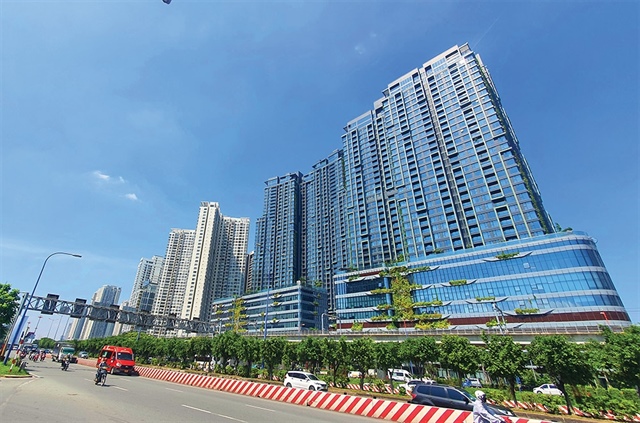
Greener building materials enter the Vietnamese market, Photo: Le Toan |
Advanced production
According to Nguyen Trong Hien, chairman of the board of Gelex Group, the green transformation strategy has become a top priority in the group’s production and business activities. The group aims to allocate up to 2 per cent of its revenue to R&D activities, digital transformation, and the development of high-quality personnel.
“Not only do we apply advanced production technologies to reduce emissions, but our member companies also invest in rooftop solar power systems, while optimising processes to reduce raw material consumption,” Hien said.
Green materials are becoming increasingly popular thanks to the development of green buildings. According to the Ministry of Construction, green buildings have appeared in Vietnam for over 15 years, with the first projects in Ho Chi Minh City and later expanding nationwide.
Last June, SCG Group launched its first SCG low-carbon super cement in Vietnam. The new product is environmentally friendly thanks to the application of advanced production technologies, reducing carbon emissions by 20 per cent during the manufacturing process.
Each tonne of SCG low carbon super cement contributes to reducing carbon emissions equivalent to the CO2 absorption of 12 mature trees in one year.
Last September, Fico Tay Ninh Cement also introduced a green label cement to the market with emissions levels of only about 350-600kg of CO2 per tonne, reduced by up to 70 per cent compared to conventional cement.
Supporting companies
Meanwhile, enterprises operating in the paint and coatings industry are also not left behind in the race as they are improving technology to supply green product lines.
Le Dong Lam, CEO of PPG Vietnam, a company specialising in paints, coatings, and speciality materials, stated that the company had recently expanded its factory and improved technology to introduce new solutions to the market that align with customers’ demand for green products.
“PPG sets the goal of developing environmentally advantageous products, expanding water-based paints, powder coatings, and UV coatings. By 2030, approximately half of the company’s revenue will come from environmentally advantageous products,” Lam said.
According to chairman of the Vietnam Association for Building Materials (VABM) Tong Van Nga, demand for environmentally friendly materials is increasing due to the environmental awareness and the practical benefits such as reduced operating costs and extended lifespan of construction projects.
However, the biggest barrier is that green materials have higher production costs compared to traditional materials, posing challenges for construction contractors or consumers in accessing and using them.
“Buildings using green materials can reduce greenhouse gas emissions by up to half,” Nga said. “However, the investment cost for green buildings is 5-25 per cent higher than traditional materials, creating budget pressures for both investors and contractors.”
The Architecture Law and regulations on energy efficiency, design regulations from the Ministry of Construction, and tax incentives for green buildings have made these types of materials increasingly popular, added Nga.
To support businesses in encouraging the use of green buildings, he said that Vietnam has issued several legal documents such as the Environmental Protection Law, a strategy on development of Vietnam’s construction materials industry, and rules on management of construction materials covering this decade.
According to the World Bank, Vietnam boasted around 560 green-certified projects by the end of 2024, far exceeding the government’s targets of 80 green projects by the end of 2025 and 160 green projects by 2030.
Projects in Vietnam mainly apply three certification systems: EDGE (approximately 42 per cent), LEED (39 per cent), and Green Mark from Singapore (14 per cent). The flexible application of multiple systems helps the market access various international standards and also compels material and equipment suppliers to upgrade accordingly.
|
Dr. Tran Quoc Tuan, president Vietnam Science and Technology Association for Standards and Quality To achieve net-zero emissions by 2050, businesses must focus on applying quality standards linked to environmental protection. Government involvement is also essential through the introduction of supportive policies, followed by businesses playing a crucial role in execution. Businesses need to integrate a quality management system and an environmental management system, rather than just apply in form. Additionally, companies must actively embrace green transformation, linking the perspective on quality standards with environmental protection. This should be applied from the product design process, material selection, production, packaging, preservation, and transportation to consumers. To achieve that, they must adopt new technologies and cleaner, greener materials. Apart from products, businesses also need to use green energy sources and renewable energy to make their production processes more environmentally friendly. Currently, the government has a policy of conducting emissions inventories for businesses to identify the causes of emissions, starting from raw materials to the entire production process. Once businesses become aware of this, I believe we will succeed in achieving the net-zero target. Dr. Phung Anh Tuan, deputy head of Electrical Engineering, Hanoi University of Science and Technology Vietnam is striving to reduce the impact of urbanisation and industrialisation on the environment. Therefore, it is important to pay more attention to energy balance targets and introducing environmentally friendly products. Using environmentally friendly materials is a mandatory prerequisite for green buildings. The criteria for environmental friendliness are not only reflected in each product, but also in the technology equipment, vehicles, methods, and energy consumption levels used for the production and manufacturing of products. Furthermore, these materials must meet factors such as low-energy consumption and natural origin. This is also a major challenge when products still must meet the increasingly high technical requirements of the market. Green buildings are buildings that meet four important criteria. It must save energy by using optimal technology and materials to reduce electricity, water, and resource consumption. It should also apply environmentally friendly materials, limiting the use of products harmful to the environment and human health. Efficient waste management is essential, with appropriate solutions for waste and wastewater treatment to minimise pollution. In addition, it is necessary to create a healthy living environment, improve air quality, utilise natural light and green spaces to enhance the quality of life. |
- 16:04 22/05/2025




